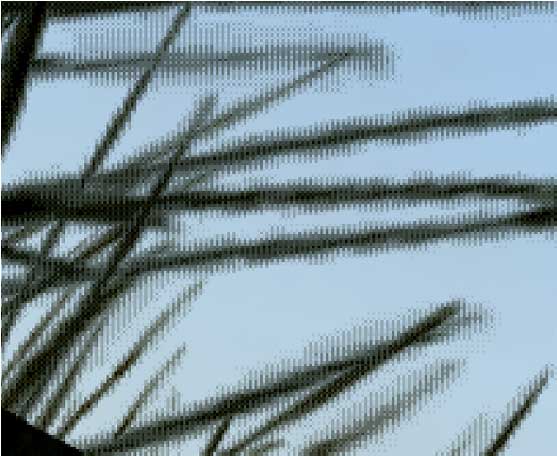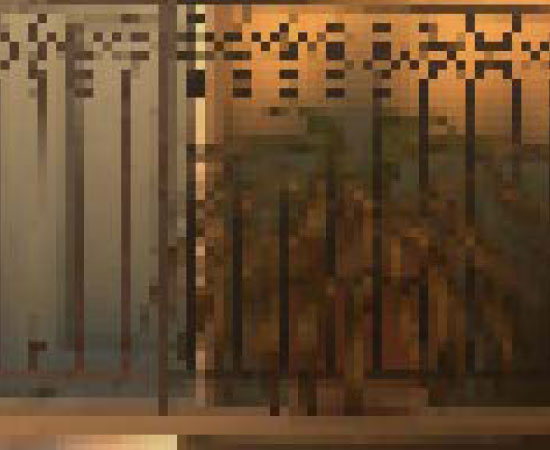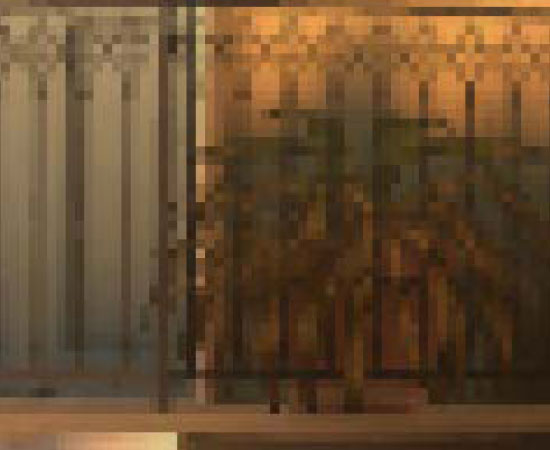Better Image Quality: CSAA & TMAA
NVIDIA’s next big trick for image quality is that they’ve revised Coverage Sample Anti-Aliasing. CSAA, which was originally introduced with the G80, is a lightweight method of better determining how much of a polygon actually covers a pixel. By merely testing polygon coverage and storing the results, the ROP can get more information without the expense of fetching and storing additional color and Z data as done with a regular sample under MSAA. The quality improvement isn’t as pronounced as just using more multisamples, but coverage samples are much, much cheaper.

32x CSAA sampling pattern
For the G80 and GT200, CSAA could only test polygon edges. That’s great for resolving aliasing at polygon edges, but it doesn’t solve other kinds of aliasing. In particular, GF100 will be waging a war on billboards – flat geometry that uses textures with transparency to simulate what would otherwise require complex geometry. Fences, leaves, and patches of grass in fields are three very common uses of billboards, as they are “minor” visual effects that would be very expensive to do with real geometry, and would benefit little from the quality improvement.
Since billboards are faking geometry, regular MSAA techniques do not remove the aliasing within the billboard. To resolve that DX10 introduced alpha to coverage functionality, which allows MSAA to anti-alias the fake geometry by using the alpha mask as a coverage mask for the MSAA process. The end result of this process is that the GPU creates varying levels of transparency around the fake geometry, so that it blends better with its surroundings.
It’s a great technique, but it wasn’t done all that well by the G80 and GT200. In order to determine the level of transparency to use on an alpha to coverage sampled pixel, the anti-aliasing hardware on those GPUs used MSAA samples to test the coverage. With up to 8 samples (8xQ MSAA mode), the hardware could only compute 9 levels of transparency, which isn’t nearly enough to establish a smooth gradient. The result was that while alpha to coverage testing allowed for some anti-aliasing of billboards, the result wasn’t great. The only way to achieve really good results was to use super-sampling on billboards through Transparency Super-Sample Anti-Aliasing, which was ridiculously expensive given that when billboards are used, they usually cover most of the screen.
For GF100, NVIDIA has made two tweaks to CSAA. First, additional CSAA modes have been unlocked – GF100 can do up to 24 coverage samples per pixel as opposed 16. The second change is that the CSAA hardware can now participate in alpha to coverage testing, a natural extension of CSAA’s coverage testing capabilities. With this ability CSAA can test the coverage of the fake geometry in a billboard along with MSAA samples, allowing the anti-aliasing hardware to fetch up to 32 samples per pixel. This gives the hardware the ability to compute 33 levels of transparency, which while not perfect allows for much smoother gradients.
The example NVIDIA has given us for this is a pair of screenshots taken from a field in Age of Conan, a DX10 game. The first screenshot is from a GT200 based video card running the game with NVIDIA’s 16xQ anti-aliasing mode, which is composed of 8 MSAA samples and 8 CSAA samples. Since the GT200 can’t do alpha to coverage testing using the CSAA samples, the resulting grass blades are only blended with 9 levels of transparency based on the 8 MSAA samples, giving them a dithered look.

Age of Conan grass, GT200 16x AA
The second screenshot is from GF100 running in NVIDIA’s new 32x anti-aliasing mode, which is composed of 8 MSAA samples and 24 CSAA samples. Here the CSAA and MSAA samples can be used in alpha to coverage, giving the hardware 32 samples from which to compute 33 levels of transparency. The result is that the blades of grass are still somewhat banded, but overall much smoother than what the GT200 produced. Bear in mind that since 8x MSAA is faster on the GF100 than it was GT200, and CSAA has very little overhead in comparison (NVIDIA estimates 32x has 93% of the performance of 8xQ), the entire process should be faster on GF100 even if it were running at the same speeds as GT200. Image quality improved, and at the same time the performance improved too.

Age of Conan grass, GF100 32x AA
The ability to use CSAA on billboards left us with a question however: isn’t this what Transparency Anti-Aliasing was for? The answer as it turns out is both yes and no.
Transparency Anti-Aliasing was introduced on the G70 (GeForce 7800GTX) and was intended to help remove aliasing on billboards, exactly what NVIDIA is doing today with MSAA. The difference is that while DX10 has alpha to coverage, DX9 does not – and DX9 was all there was when G70 was released. Transparency Multi-Sample Anti-Aliasing (TMAA) as implemented today is effectively a shader replacement routine to make up for what DX9 lacks. With it, DX9 games can have alpha to coverage testing done on their billboards in spite of DX9 not having this feature, allowing for image quality improvements on games still using DX9. Under DX10 TMAA is superseded by alpha to coverage in the API, but TMAA is still alive and well due to the large number of older games using DX9 and the large number of games yet to come that will still use DX9.
Because TMAA is functionally just enabling alpha to coverage on DX9 games, all of the changes we just mentioned to the CSAA hardware filter down to TMAA. This is excellent news, as TMAA has delivered lackluster results in the past – it was better than nothing, but only Transparency Super-Sample Anti-Aliasing (TSAA) really fixed billboard aliasing, and only at a high cost. Ultimately this means that a number of cases in the past where only TSAA was suitable are suddenly opened up to using the much faster TMAA, in essence making good billboard anti-aliasing finally affordable on newer DX9 games on NVIDIA hardware.
As a consequence of this change, TMAA’s tendency to have fake geometry on billboards pop in and out of existence is also solved. Here we have a set of screenshots from Left 4 Dead 2 showcasing this in action. The GF100 with TMAA generates softer edges on the vertical bars in this picture, which is what stops the popping from the GT200.

Left 4 Dead 2: TMAA on GT200

Left 4 Dead 2: TMAA on GF100










115 Comments
View All Comments
chizow - Monday, January 18, 2010 - link
Looks like Nvidia G80'd the graphics market again by completely redesigning major parts of their rendering pipeline. Clearly not just a doubling of GT200, some of the changes are really geared toward the next-gen of DX11 and PhysX driven games.One thing I didn't see mentioned anywhere was HD sound capabilities similar to AMD's 5 series offerings. I'm guessing they didn't mention it, which makes me think its not going to be addressed.
mm2587 - Monday, January 18, 2010 - link
for nvidia to "g80" the market again they would need parts far faster then anything amd had to offer and to maintain that lead for several months. The story is in fact reversed. AMD has the significantly faster cards and has had them for months now. gf100 still isn't here and the fact that nvidia isn't signing the praises of its performance up and down the streets is a sign that they're acceptable at best. (acceptable meaning faster then a 5870, a chip that's significantly smaller and cheaper to make)chizow - Monday, January 18, 2010 - link
Nah, they just have to win the generation, which they will when Fermi launches. And when I mean "generation", I mean the 12-16 month cycles dictated by process node and microarchitecture. It was similar with G80, R580 had the crown for a few months until G80 obliterated it. Even more recently with the 4870X2 and GTX 295. AMD was first to market by a good 4 months but Nvidia still won the generation with GTX 295.FaaR - Monday, January 18, 2010 - link
Win schmin.The 295 ran extremely hot, was much MUCH more expensive to manufacture, and the performance advantage in games was negligible for the most part. No game is so demanding the 4870 X2 can't run it well.
The geforce 285 is at least twice as expensive as a radeon 4890, its closest competitor, so how you can say Nvidia "won" this round is beyond me.
But I suppose with fanboy glasses on you can see whatever you want to see. ;)
beck2448 - Monday, January 18, 2010 - link
Its amazing to watch ATI fanboys revise history.The 295 smoked the competition and ran cooler and quieter. Fermi will inflict another beatdown soon enough.
chizow - Monday, January 18, 2010 - link
Funny the 295 ran no hotter (and often cooler) with a lower TDP than the 4870X2 from virtually every review that tested temps and was faster as well. Also the GTX 285 didn't compete with the 4890, the 275 did in both price and performance.Its obvious Nvidia won the round as these points are historical facts based on mounds of evidence, I suppose with fanboy glasses on you can see whatever you want to see. ;)
Paladin1211 - Monday, January 18, 2010 - link
Hey kid, sometimes less is more. You dont need to post that much just to say "nVidia wins, and will win again". This round AMD has won with 2mil cards drying up the graphics market. You cant change this, neither could nVidia.Just come out and buy a Fermi, which is 15-20% faster than a HD 5870, for $500-$600. You only have to wait 3 months, and save some bucks until then. I have a HD 5850 here and I'm waiting for Tegra 2 based smartphone, not Fermi.
Calin - Tuesday, January 19, 2010 - link
Both Tegra 2 and Fermi are extraordinary products - if what NVidia says about them is true. Unfortunately, it doesn't seem like any of them is a perfect fit for the gaming desktop.Calin - Monday, January 18, 2010 - link
You don't win a generation with a very-high-end card - you win a generation with a mainstream card (as this is where most of the profits are). Also, low-end cards are very high-volume, but the profit from each unit is very small.You might win the bragging rights with the $600, top-of-the-line, two-in-one cards, but they don't really have a market share.
chizow - Monday, January 18, 2010 - link
But that's not how Nvidia's business model works for the very reasons you stated. They know their low-end cards are very high-volume and low margin/profit and will sell regardless.They also know people buying in these price brackets don't know about or don't care about features like DX11 and as the 5670 review showed, such features are most likely a waste on such low-end parts to begin with (a 9800GT beats it pretty much across the board).
The GPU market is broken up into 3 parts, High-end, performance and mainstream. GF100 will cover High-end and the top tier in performance with GT200 filling in the rest to compete with the lower-end 5850. Eventually the technology introduced in GF100 will diffuse down to lower-end parts in that mainstream segment, but until then, Nvidia will deliver the cutting edge tech to those who are most interested in it and willing to pay the premium for it. High-end and performance minded individuals.